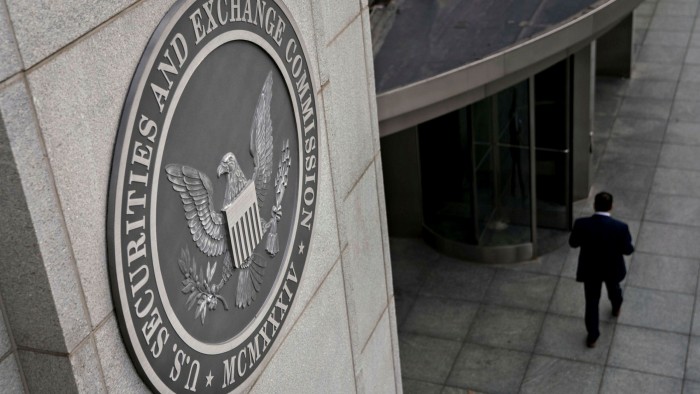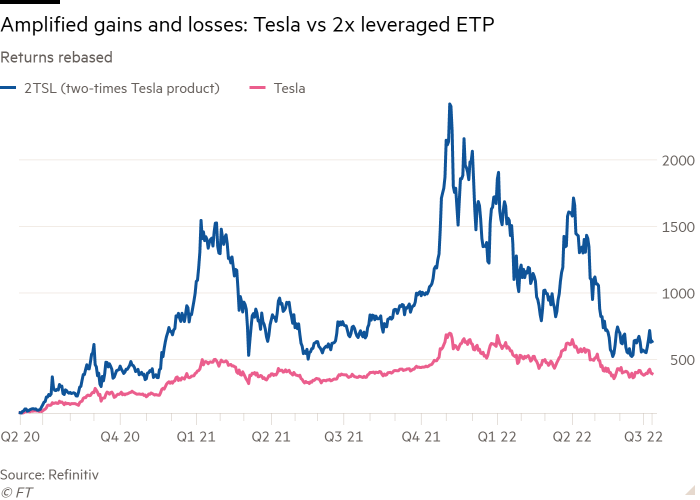SEC warns investors about new single-stock leveraged ETFs

Simply sign up to the Exchange traded funds myFT Digest -- delivered directly to your inbox.
Senior officials from the top US markets regulator have warned of the risks of single-stock leveraged exchange traded funds, speaking out ahead of the products’ imminent launch.
Lori Schock, director of the Securities and Exchange Commission’s office of investor education and advocacy, said the new products were even riskier than existing leveraged and inverse ETFs, which provide daily amplified losses and gains on the securities they track and which the SEC has already warned against.
Schock said in a statement on Monday evening that in addition to the risks posed by other leveraged products, the single-stock versions also lacked the benefits of diversification.
“Investors holding these funds will experience even greater volatility and risk than investors who hold the underlying stock itself,” added Schock.
SEC commissioner Caroline Crenshaw said regulatory changes adopted in 2019 had relaxed the approval process for new ETFs but policymakers had not anticipated the updated rules would pave the way for leveraged single-stock ETFs.
“I am disappointed that, months after [former commissioner Allison] Lee and I called for improvements to the rules for complex exchange traded products, we have not updated our regulatory framework to better address the risks these products pose to investors and the markets,” said Crenshaw.
Leveraged and inverse ETFs are designed to allow investors to take short-term bets on the direction of a security, and provide, for example, two or three times the daily returns or, in the case of inverse ETFs, two or three times the opposite of the daily returns of the underlying security. They reset every day, which means a long-term investor in a two-times fund, for example, would suffer magnified losses on any day when the underlying securities lost value.
“Investors should be aware that if they were to hold these funds for longer than a day, the performance of these funds may differ significantly from the levered and/or inverse performance of the underlying stock during the same period of time,” said Schock.

Tyler Gellasch, executive director of the Healthy Markets Association, an investor advocacy group, also warned against the products. He pointed out that retail investors often tended to make financial decisions that were “destructive to their long-term wellbeing”.
Providing access to leveraged and inverse vehicles to retail investors was especially risky, said Gellasch. “It’s not unlike a firearm. A gun can be useful for a well-trained professional, but most people are not well trained.”
Worse still, he said, it was clear that the products were aimed directly at retail investors because institutions already had access to similar leveraged strategies.
“The goal of the products is to sell something that is very complex and risky to the masses,” said Gellasch.
Leveraged and inverse single-stock ETFs were first launched in Europe in 2018. Leverage Shares has $135mn in assets under management across 123 single-security products, while rival GraniteShares had 77 vehicles with combined assets of $114mn at the end of June, according to ETFGI, a London-based consultancy. *
Leverage Shares announced this week that it was launching a white-label exchange traded product service to help other providers enter the market in Europe, potentially opening the floodgates to many more products.
Raj Sheth, commercial director of Leverage Shares, dismissed fears that the products should be more tightly regulated.
“Are they risky? I would say yes, but we are not competing with [plain vanilla] ETFs. We are competing with products that are more risky like margin products [which rely on borrowing],” he said.
*This article has been amended to correct the value of GraniteShares’ total AUM in single stock products
Latest news on ETFs
Visit our ETF Hub to find out more and to explore our in-depth data and comparison tools

Comments